With the development of the information age, people are increasingly pursuing a smart and convenient life, and the park is gradually developing into a smart park. A smart park refers to a new type of park that combines the use of new-generation information technologies such as the Internet of Things, cloud computing, and big data to comprehensively upgrade the park, integrate park resource information, and independently innovate service systems. The construction of smart parks is not blind. Different functional parks have different characteristics. The smart construction should be completed around the main needs of the park, providing convenient interaction methods for the park and the enterprises settled in the park, and realizing the intelligent management of the park.
Pain points of property management: There are complex people around the community, people entering and leaving frequently, and the management range is wide and difficult, requiring a lot of manpower and material resources. The management methods are primitive, and basically rely on manual patrols to manage, which cannot guarantee the demands of the owners.
Clarity pain points: Some residential areas have old monitoring equipment, the images are not clear enough, and the quality of the images at night is poor, making it difficult to verify afterwards.
Pain points of owners’ property safety: Thieves and other criminals climb over the fence, unable to generate early warning in time, posing a threat to the owner’s personal and property safety.
Convenience pain points for owners: A fixed key card is required to enter the park, which is often forgotten, causing inconvenient access.
Design
This solution uses a multi-access edge computing device to connect cameras to control the gates of residential quarters, monitoring rooms, entrances of unit buildings, elevators, squares, lawns/fountains, and the perimeter of the park at multiple points, forming an intelligent and efficient management of the park .
①The gate of the community: connect the existing camera to our edge-end AI equipment to realize face capture and feature value extraction, and give an alarm if you don’t wear a mask;
②Monitoring room: Connect the existing cameras to our edge-end AI equipment to realize stranger recognition and face query;
③The entrance of the unit building: connect the existing camera to our edge-end AI equipment to realize stranger recognition;
④Park perimeter: Connect the existing cameras to our edge-end AI equipment to realize perimeter intrusion detection, which is clearly visible for 24 hours;

Core Scenario 1: Rapid passage of personnel at the entrance and exit of the community, improving the experience of the community
The entrance of the community is an area with high flow of people, and the pedestrians passing by are uneven. Connect the existing cameras to our edge-end AI devices to monitor people who appear at the entrance of the community and behave abnormally, coordinate the cameras based on the edge-end devices to issue local real-time alarms, remind the security personnel of the community to be more vigilant, and at the same time warn non-owners and tenants to identify, to prevent strange and suspicious persons from intruding into the community, to ensure the safety of the owners of the community. For the extraordinary period of large-scale infectious diseases, it can also supervise and control some diehards who do not wear masks to ensure public safety and hygiene in the community.

Core scene 2: Personnel screening at the entrance of the unit building, dynamic face detection
Connecting existing cameras to our edge-end AI devices can realize 24-hour situational awareness, identify visits from non-unit building owners, and push alarms in real time on mobile APPs. Realize the convenient access to the owners by swiping their faces.
Connect the existing cameras to our edge-end AI equipment to identify strangers visiting non-unit building owners, reduce the management and control of strange visitors by the property, and at the same time realize the query of personnel frequency, and take into account 24-hour high-definition video surveillance at the same time.
Connecting existing cameras to our edge-end AI devices can accurately identify non-motor vehicles and link sound columns to realize scene-based language reminders, telling residents of the community not to park non-motor vehicles at will.

Core Scenario 3: Intelligent monitoring and prevention of park perimeters, cross-border intrusions, and accurate perimeter control
Connect the existing camera to the edge-side AI device, monitor the screen in full color for 24 hours, accurately detect the human body and vehicle targets and capture them; effectively filter out false alarm targets such as animals, leaves, light and shadow, etc., and the alarm accuracy rate is over 95% during the day and 90% at night % or more, and at the same time, local alarm output and remote APP alarm push can be realized.
① Elevator: Connect the existing camera to the edge-side AI device to realize 24-hour situation monitoring and simultaneous recording of audio and video;
②Square: connect the existing cameras to the edge-end AI equipment to realize 24-hour situation monitoring;
③ Lawn/Fountain: Connect the existing camera to the edge-side AI device to realize 24-hour situational awareness and early warning of emergencies;
④Building: Connect the existing camera to the edge-side AI device to realize high-altitude parabolic video backtracking;
⑤Fire exit: connect the existing camera to the AI device at the edge to realize the detection and reminder of vehicles illegally parked in the fire exit;